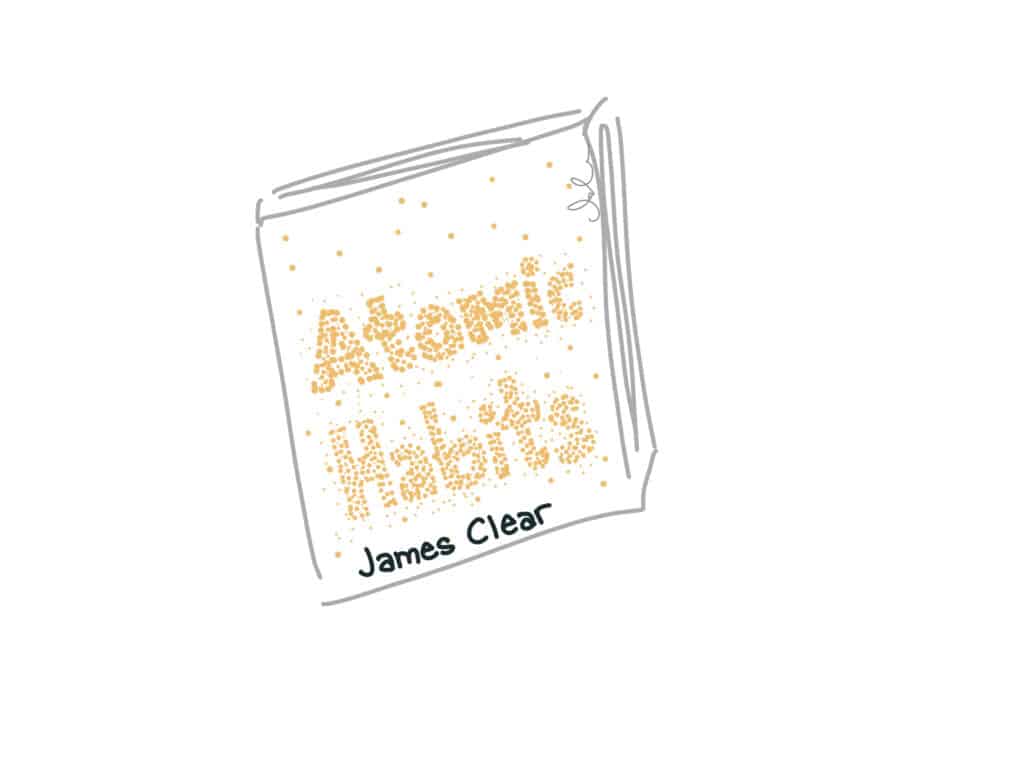Another book which has affected my entire life, both the business and the personal, is Atomic Habits by James Clear. I’d had it recommended to me by many people, so it was another book which had been on my list for ages.
As with many books “everybody” seems to be impressed by, I tend to avoid them for a while. Probably out of sheer stubbornness. But I distinctly remember the moment which inspired me to buy and read the book at last. I was sitting on an overground train in London, on my way to the airport, and was whiling away the time listening to a podcast. This particular one had James Clear as a guest, and they were discussing some of the core principles of the book.
The things he shared were so specific and so practical I felt like I could start doing them straight away. I bought it, read it, and then shared it with the team and we all read it together. It’s now one of my top recommended books of all time.
The key for books I recommend is lasting power. It’s great to read a book and feel briefly inspired or intrigued or get a few ideas. But what really moves a book to the top of my list is when I look back over a year or two and see how I’ve been living out the principles (sometimes without even realising it).
Here are the principles I’ve been applying from Atomic Habits:
The 1% changes, accumulated, are what drive big change
It’s the accumulation of small, almost minuscule or invisible, changes which get you to the big results. You don’t simply decide something, do it, and then suddenly have huge results the next day. This one particularly struck me in relation to marketing – at PF we proclaim that the right way is the long way – but it’s also true for building healthy habits or being able to walk or run further or finishing a book or building a company.
Habit stacking: Connect a habit you don’t like with something you do like
Building a new habit isn’t pleasant. You have to do things differently and it can feel uncomfortable. To fix this, connect the new desired habit (which isn’t consistent yet) with an existing comfortable habit. Or even something which always happens – like the sun rising or your alarm going off or pressing the ‘on’ button of the coffee machine.
If I want to start building a habit of eating healthier breakfasts, I need to connect it to my morning coffee. Because the chances of me skipping coffee are…well, let’s just say my sister texted me a poster which said “Coffee…because murder is wrong”. And my morning coffee routine looks a little different because of my beautiful bean-to-cup grinder machine; so I need to press a button and wait….press another button and wait…and do that several times to get the elixir of life. So the moment I press the button to start up the machine, I can connect that with taking out the blender. And when I press the other button, I fill up the blender with fruit and protein powder and orange juice. And when I press the final button, I start the blender. Lo and behold, I now have coffee (which i’m programmed to have), and I also have the new habit of a morning smoothie. Done and dusted.
What you put visibly in front of you helps change habits
James Clear used the example of leaving apples out instead of sweets, and I remember reading this and going downstairs and seeing the jelly beans I had sitting out on a counter. It was so easy to pick up one jelly bean, every time I passed, and by the end of the day I’d eaten quite a lot of them. If I wanted to make healthy choices, the jelly beans needed to be moved out of sight, and I’d forget they were there and only eat them when I consciously planned to.
One change I’ve made because of this is a bottle of water which stands on a table downstairs (where the jelly beans used to be). Every time I walk by it, I take one sip of water. It is so small. It’s the 1%. But it accumulates, and by the end of the day I’ve nearly finished the whole bottle of water because of how often I pass it.
Don’t skip twice
This one is helpful, but I’ll be honest: I don’t practice it. The concept is when you’re building a habit, skipping it once doesn’t throw you off the rails, but skipping twice puts you in danger of giving up the habit altogether. So if I’m building (or re-building) the habit of going for a walk every day, and I go on Sunday and Monday and Tuesday, but skip Wednesday, I need to make sure I go on Thursday or else I’ve skipped twice. And a new habit of “not going” is building.
In principle I agree with this one. I do see the power of the small thing done every day. And when I look at some of the results I don’t like in my life – like being tired all the time and not fitting into my clothes well – I know my choices to skip twice, or three times, or ten times, or for months, affect these results.
But I also struggle with the “don’t skip twice” because it feels so restrictive. As if I feel more freedom by doing what I want to do – going for a walk or not going. And yet when I think about it, I don’t have the freedom to go where I want and do what I want if my energy is low and my weight is higher than it needs to be. Those things are preventing me being free and energetic and enthusiastic. They’re preventing the good things I want…so I fight back by putting on my shoes and stepping out the door. I still do skip twice many times, but I also keep going too. So skipping twice doesn’t defeat me entirely: it simply makes achieving my goals take a little longer.
Star charts work for adults, too
For those of you who have children (or most of us will remember this from being a child), you know the power of the star chart. You make a homework chart or a chores chart or a going-pee chart, and every time the child achieves one small thing, you put a gold star in the box for that day. Or a tick, or a sticker, or whatever.
Turns out these work great for adults, too. When I was working on making healthier choices I had simplified my daily tasks down to four things – going for a walk (at least 15 minutes), tracking my calories, and doing sit-ups and pushups (one more each day up to 100). I took a piece of paper, drew out lines and boxes, put it up on my bookcase where I saw it every morning as I came into my office, and literally ticked off with a different coloured sharpie which of the four things I’d done that day.
I did brilliantly…until the chart ended. I got to the end and thought “I need to create a new one”, and then a day went by and then a week and then a few months and suddenly I’d gotten completely out of the habits.
In the past month I’ve started again, and I have a new chart, and this time I’m going to prepare page two and have it ready for the moment the first page is filled up!
Success comes from small wins and tiny breakthroughs
We love the big successes, the victories. The published book. The business sale. The graduation. The award. But all of those are the result of little victories along the way, and those little victories accumulate because of the daily habits. Writing a few words every morning. Building new processes in the business and hiring the right people. Studying for an hour every evening. And then you find yourself finishing the manuscript, which is a little victory, and eventually publishing the book, which is the great victory. Focus on the daily habits and the small victories. Those will accumulate.
I wrote most of these from memory, because they were so clear in my mind and so practical. I did pick up the book itself again, and this morning I decided it was time to re-read it, and remind myself of how to rebuild the habits I want. Ultimately it’s not the habit I care about: it’s the result I want. And to get that result….habits. So if I intend to actually read it, I need to use my learnings from the first time round, and apply them, which includes:
- Go find the book (it was on my bookshelf in the office)
- Put the book on my bedside table (so it’s ready to grab easily in the morning)
- Connect it to an existing habit (coffee and reading a chapter of a book every morning)
- Read a chapter this morning to start
- Pick it up tomorrow morning and continue
- …and do my darndest not to skip twice!!
How about you? What habit would you like to build?



